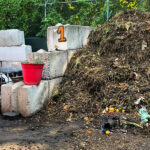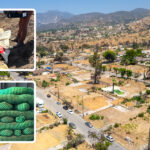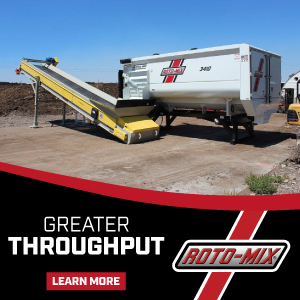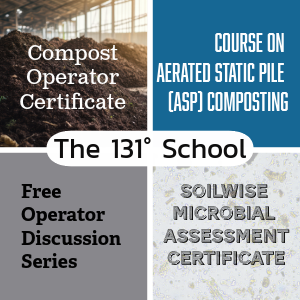Top: Back hoe is used after compost is applied to create “veins” of compost below the soil. Photo from webinar that explains the Soil Profile Rebuilding procedure.
Craig Coker
As more local governments adopt mandates to amend disturbed soils to increase soil organic matter and help manage storm water, specifications have been developed to ensure the practice is done correctly. Virginia Tech in Blacksburg, Virginia is a case in point. Research, led by Susan Day and the Urban Forest Ecosystems Lab at Virginia Tech, evaluated the effects of Soil Profile Rebuilding (SPR) on ecosystem service provision to assess its suitability as a post-land development soil rehabilitation technique that includes use of compost. SPR is a cost-effective method that can help rehabilitate these soils to provide documented increases in tree growth and ecosystem services such as carbon sequestration and storm water management.
Day and her team’s research led to creation of the “Specification for Restoration of Graded and Compacted Soils that will be Vegetated.” SPR can improve physical and biological characteristics of soil to allow for revegetation. It does not address soil chemical problems, soil contamination from heavy metals, pathogens, excessive debris or gravel. This article summarizes components of the SPR specification.
Purpose And Expected Outcomes
SPR is an appropriate soil restoration technique for sites where topsoil has been completely or partially removed and subsoil layers have been compacted (graded and/or trafficked by equipment) such as the staging areas near building or road construction sites. It may also be used with some modifications if topsoil is present. This is not an appropriate technique at sites with surface compaction only (6 inches or less), although this situation is rare on construction sites. SPR is not appropriate within the root zones of trees that are to be protected since it will break apart existing tree roots.
The procedure includes a subsoiling step, addition of organic matter in the form of compost, replacement or addition of topsoil followed by tilling, and subsequent planting with woody plants. The soil preparation portion of SPR puts the components in place for restoration of the soil to a state where it may achieve many of the functions of undisturbed soils, however, the complete restoration process requires root activity and occurs over many years. Expected outcomes may include improvements in vegetation establishment, increased tree growth rates, increased soil permeability, enhanced formation of aggregates in the subsoil, and enhanced long-term soil carbon storage. This technique may be appropriate for restoration of disturbed soils as defined by SITES™ (the Sustainable Sites Initiative).
Procedures
SPR should take place after site disturbance is complete, including all vehicle and equipment trafficking, but before replacement of topsoil. Before beginning, remove all foreign materials resulting from construction operations, including oil drippings, stone, gravel, and other construction materials from the existing soil surface. If topsoil is already present and is 4 inches or greater in depth, use the modified procedure for Step Three.
- Step One: Apply 4 inches of compost over surface
Spread mature, stable compost (see Definitions below) to a 4-inch depth over compacted subsoil.
- Step Two: Subsoil with backhoe to 24-inch depth
Subsoiling should be performed when soil is neither wet nor dry. Use a backhoe rear bucket or similar equipment with a tined bucket to break up the compacted soil and incorporate the compost. Work backwards away from excavated soils so that treated soil is not trafficked by the equipment. Insert the bucket through the compost layer and into the subsoil to a depth of 24 inches and raise a bucket of soil a few feet above the soil surface. Tip the bucket and allow soil to fall. Repeat this procedure until no clumps of compacted soil larger than 12 inches in diameter remain. The tines of the bucket can be used to break apart larger clumps if necessary. Continue to break up clumps until at least 50% of the soil is in clumps 6 inches or smaller. A push tube soil sampler can be used to verify compost is present at 24-inch depth if needed. The subsoiling is not intended to homogenize the compost and soil, but rather loosen the soil to a 24-inch depth and create veins of compost down to that depth as well.
- Step Three: Replace or add topsoil
Standard procedure — no topsoil was present during subsoiling: Return stockpiled topsoil, or additional topsoil if none is available from the site, to the soil surface to a 4-inch minimum depth. If soil was severely disturbed (for example, the grade was lowered, or the site was compacted in lifts), 6 to 8 inches should be used.
Modified procedure — significant topsoil was already present before subsoiling: Somewhat less topsoil can be used if significant topsoil was already present before subsoiling, but always apply at least 3 inches since much of the pre-existing topsoil will have become incorporated in the subsoil.
- Step Four: Till the topsoil and break up the topsoil subsoil interface
Rototill topsoil to a depth of 6 to 8 inches when soil is neither dry nor very moist. Rototilling depth should ideally cross the interface with the subsoiled layer.
- Step Five: Planting
Plant the site with woody plants, trees or shrubs, such that at least half the area will be colonized by roots within about ten years. The plant roots will exploit the loosened subsoil and compost veins and then continue to contribute organic matter and work the soil over time to develop soil structure throughout the profile.
Topsoil And Compost Definitions
Topsoil: Soil can be considered topsoil if it originates from an A horizon of a natural soil or is a mineral soil with 3% or greater organic matter content and a NRCS (Natural Resources Conservation Service) textural class similar to predevelopment A horizon soils for the site (if these are known). Ensure topsoil is free of debris, stones, gravel, trash, etc. Limestone gravel should be kept separate from soil as much as possible as it will raise the soil pH to levels inhospitable to most plants.
Compost: Use high quality, mature, stable compost made from leaves, yard trimmings, or food waste. Stability refers to the rate of biological breakdown, measured by carbon dioxide release. Maturity refers to completeness of the aerobic composting process and suitability (lack of plant toxicity) as a plant growth media, often measured by ammonia release and by plant growth tests. Compost should also be: Free of weed seeds; free of heavy metals or other deleterious contaminants; and have an electrical conductivity (EC) of less than 4.0 mmhos/cm.
Compost manufacturers that subscribe to the US Composting Council’s Seal of Testing Assurance (STA) program may document stability as compost testing 7 or below in accordance with TMECC 05.08-B, “Carbon Dioxide Evolution Rate.” Maturity (suitability for plant growth) may be documented as compost testing greater than 80% in accordance with TMECC 05.05-A, “Germination and Vigor.” Compost is considered mature and stable if it tests at 6.0 or higher on the Solvita Compost Maturity Index Rating, which is a combination of carbon dioxide and ammonia maturity tests (test information and equipment available at www.solvita.com).
Craig Coker is a Senior Editor at BioCycle CONNECT and a Principal in the firm Coker Composting & Consulting, near Roanoke VA.














